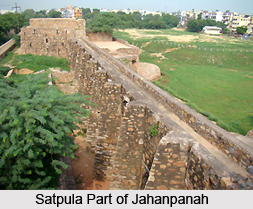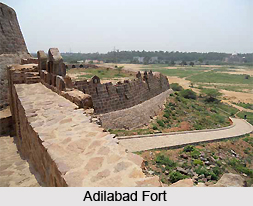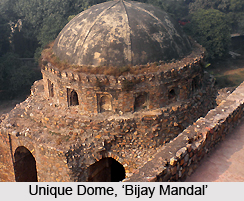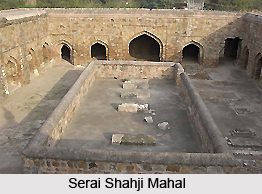 Jahanpanah is located in South Delhi and is the fourth city of the capital of Delhi, established during the medieval age by Muhammad-bin-Tughlaq during the period from 1326 till 1327. The city was strongly fortified by the ruler of Delhi Sultanate, Muhammad-bin-Tughlaq to defend it from the frequent dangers of Mongol invasions. The term `Jahanpanah` implies `Refuge of the World` in the Persian language. However, presently the city of Jahanpanah and also the fort in it no longer exists due to several conceived notions one of which has stated that Mohammad-bin-Tughlaq had moved his official capital to Daulatabad in the Deccan and had returned much later. Therefore Jahanpanah had mysteriously disappeared or had been destroyed. Visitors often come across the remnants of the city walls which are situated on the road between Qutub Minar and Siri as well as in separated patches behind Khirki Masjid close to Khirki village, Satpula and Indian Institute of Technology or IIT in Begumpur. Archaeologists have discovered various ancient monuments in the colonies and villages of South Delhi, which are associated with the Jahanpanah Fort, which were excavated gradually over the years.
Jahanpanah is located in South Delhi and is the fourth city of the capital of Delhi, established during the medieval age by Muhammad-bin-Tughlaq during the period from 1326 till 1327. The city was strongly fortified by the ruler of Delhi Sultanate, Muhammad-bin-Tughlaq to defend it from the frequent dangers of Mongol invasions. The term `Jahanpanah` implies `Refuge of the World` in the Persian language. However, presently the city of Jahanpanah and also the fort in it no longer exists due to several conceived notions one of which has stated that Mohammad-bin-Tughlaq had moved his official capital to Daulatabad in the Deccan and had returned much later. Therefore Jahanpanah had mysteriously disappeared or had been destroyed. Visitors often come across the remnants of the city walls which are situated on the road between Qutub Minar and Siri as well as in separated patches behind Khirki Masjid close to Khirki village, Satpula and Indian Institute of Technology or IIT in Begumpur. Archaeologists have discovered various ancient monuments in the colonies and villages of South Delhi, which are associated with the Jahanpanah Fort, which were excavated gradually over the years.
The recent urban growth of Delhi has enveloped the region where once existed the royal city of Jahanpanah. Adchini, Panchshil Park, Malviya Nagar, the Delhi branch of Aurobindo Ashram and other small residential colonies are the various areas of Delhi through which the numerous ruins of Jahanpanah are located.
 History of Jahanpanah
History of Jahanpanah
Jahanpanah city was erected by Ghiyas- ud- din Tughlaq`s son named Muhammad-bin-Tughlaq within the period of 1326 and 1327, surrounding Lal Kot and Siri, and it was equipped with 13 gates. Lal Gumbad, Serai Shaji Mahal, Begumpur Mosque, Baradari, the Bijay Mandal which is believed to have provided shelter to the Hazar Sultan Palace which is damaged today, are amongst the ruined remains of Jahanpanah city. One will be welcomed by rubble masonry walls, broken walls of bricks and stone in this region. The records of Ibn Battuta claim that the Qutb complex or Lal Kot was the main urban settlement of Jahanpanah during 1333 to 1341 while the military cantonment was based at Siri. The rest of the vast area of Jahanpanah consisted of palace of Bijay Mandal, mosques and several other structures.
According to Ibn Battuta, Muhammad Shah desired to rule a united city involving Tughlaqabad, Jahanpanah, Siri and Old Delhi which would be held together with a strengthened fortification. However Muhammad-bin-Tughlaq abandoned this ambitious plan before it was accomplished on account of the exorbitant cost in securing the same. The chronicle composed by Ibn Battuta also maintains that this Tughlaq ruler used to dwell in the Hazar Sutan Palace which was constructed outside the confines of the Siri Fort.
It is also said that the Hazar Sutan Palace which was existent in Bijaya Mandal, Jahanpanah, boasted of splendidly carved out wooden canopy and decorated columns. Bijaya Mandal means `victory platform` in the Hindi language. In those days, the residents of the area between Siri and Qila Pithora were safe inside the Hazar Sutan Palace. The centre of governance of Tughlaq used to be Tughlaqabad, though later for unknown reasons the capital was transferred to Daulatabad for a brief period by Muhammad-bin-Tughlaq.
 Historical Structures in Jahanpanah
Historical Structures in Jahanpanah
Adilabad Fort was erected on the hills towards the southern portion of Tughluqabad and was bordered with strong fortifications. This fort was also referred to as `Muhammadabad` and possesses chambers at the lower floors and its western and eastern gateways contained courtyards and grain bins at the upper floors. The `Nai-ka-Kot` was yet another tiny fortress established about 700 metres away from Adilabad Fort. Currently, it lies in ruins.
Located in Begumpur village is existent the Begumpur Mosque which bears an Iranian architectural beauty as it had been designed by Zahir al-Din al-Jayush, who was an Iranian architect. While some historians asserted that it was constructed by Khan-i-Jahan, Firoz Shah Tughlaq`s Prime Minister who had also erected two mosques close to it while others are of the view that the mosque is attributed to Muhammad-bin-Tughlaq. It was built during 1351 AD as per the accounts of Ibn Battuta.
A significant structure in Jahanpanah is the Bijay Mandal which boasts of a square-shaped dome but is neither a palace nor a tower. It was made with rubble masonry and has been developed in an octagonal design, a typical Tughlaqi structure. It is said that it was erected such that the emperor Muhammad-bin-Tughlaq could closely monitor every movement of his royal troops. Bijay Mandal was enriched with a calm and pleasant atmosphere, along with a beautiful natural environment.
The Kalusarai Masjid is situated at the northern part of the Bijay Mandal but presently it requires urgent preservation measures for its restoration as it lies in a miserable, dilapidated condition. Khan-i-Jahan Maqbul Tilangani, the reputed builder of mosques had created the Kalusarai Masjid. The mosque was built with aide of rubble masonry and possessed seven arched openings. Tughlaqi architectural style has been implemented in the creation of this mosque.

Serai Shahji Mahal is a prominent monument existent towards the eastern portion of Begumpur Masjid, particularly in the village of Serai Shahji. A vast area of slums, ruined gates and graves are present in the vicinity of the Begumpur Mosque. The tomb of Shiekh Farid Murtaza Khan is located at a short distance away from Serai Shahji Mahal, who was famous for establishing the Faridabad village, numerous `sarais` and a mosque as well. The Lal Gumbad which was a tomb for Shaikh Kabbiruddin Auliya, a Sufi saint belonging to the 14th century and a tomb of the age of the Lodhi Dynasty are also present in the ancient Jahanpanah city.
The Archaeological Survey of India or ASI has conducted certain excavations along the walls of the Jahanpanah Fort which lie on the intersection of the eastern wall of Qila Rai Pithora. Small and rough stones have been unearthed by excavations organised here and also an ashlar face which has been dug out from the external wall above ground. Presently, the ASI is conducting renovation measures to conserve it.



















